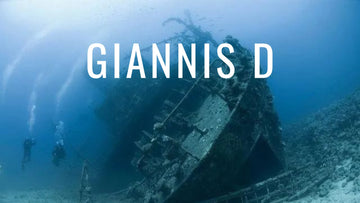The Giannis D was built by the Japanese shipping company Kuryshima and launched in 1969 as the Shoyo Maru. With a length of 87 meters and a weight of nearly 3,000 tons, this freighter was equipped with a 6-cylinder diesel engine that provided a top speed of 12 knots.
The Shoyo Maru was sold in 1975 and renamed the Markos in 1980, until it was sold again to the Greek company Dumarc, which christened it with its last and final name, the Giannis D.
Ah, before we continue with the Giannis D, did you know that we have a collection of T-shirts for divers and another with sweatshirts and T-shirts inspired by the Red Sea? In case you want to take a look ;-)
In April 1983, the Giannis D left Rijeka (Croatia) with a cargo of timber for Jeddah (Saudi Arabia) and then Al Hudaydah (Yemen). After crossing the Suez Canal, it headed south but, according to official reports, was diverted to the northwest corner of Abu Nuhas reef, where it crashed.

At 4:00 a.m. on April 19, 1983, the ship's captain issued a distress call requesting the rescue of the crew. Given the severity of the damage to the hull, which had suffered a massive 12-metre crack, the captain ordered the entire crew to abandon ship. Less than 15 minutes after the accident, Giannis D hit the bottom of the reef at a depth of 88 feet. A year later, the ship broke in half at the bottom of the Red Sea.
______________________
The best liveaboard offers in the Red Sea
______________________
Diving the Giannis D
Today we can explore the stern, bridge, cabins and engine room of the Giannis D, one of the most exciting wrecks not only in Hurghada but in the entire Red Sea. Many animals have made this wreck their home, where you can find incredible schools of thousands of glassfish occupying the bridge, batfish, lionfish hovering over the wreck, venomous stonefish, emperor angelfish, wrasses, moray eels, imposing groups of giant parrotfish and many anthias. Occasionally, bottlenose dolphins appear in the area, giving this wreck a unique aura.
The stern section is separated from the rest of the ship and its doors give us access to the engine room and several stores and warehouses. Light plays an essential role in this wreck, offering beautiful lighting effects that are much sought after by photographers who dive the Giannis D.
The central part of the wreck has collapsed after the ship broke in two and you can access two holds where the mahogany wood was transported by the ship.
The bow section is the most interesting part of the wreck, as it is still intact, lying on its back against the reef. This situation offers a unique opportunity for photography; in fact, the most famous and beautiful pictures of this wreck have been taken from this angle. From here we can see a lot of soft corals, observe the foremast, which extends almost horizontally with intact cables and pulleys, and which over the years has become a coral reef itself, with the ladder covered with abundant soft corals and reef fish.
The only way to access this wreck is through the various liveaboard dive itineraries that visit it.
Where is the Giannis D wreck?





















